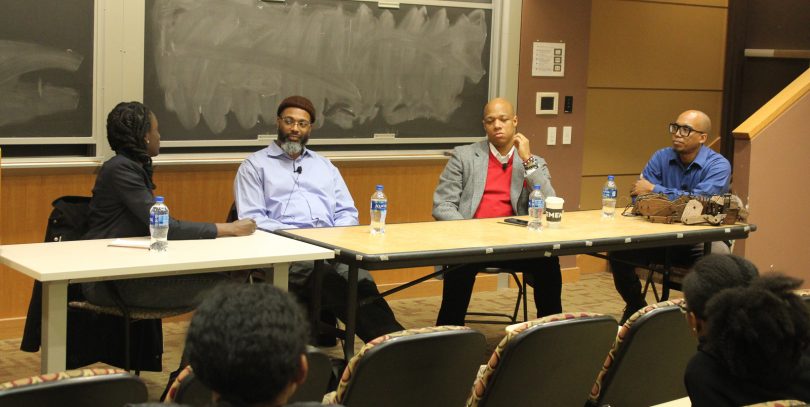By Amy Pollard
BU News Service
BOSTON — Afrofuturism became a buzzword after Black Panther, but artists were exploring the idea long before Wakanda came to the big screen.
That was a takeaway from a panel on Afrofuturism last week at BU, sponsored by the BU Arts Initiative. The panel kicked-off a series of events with artist and puppeteer Tarish “Jeghetto” Pipkins during his weeklong residency at BU.
Pipkins was joined by artists Dominique Taylor, Barrington Edwards and Joel Gill.
Afrofuturism imagines a future with people of African descent, fusing elements of science fiction and fantasy with elements of the African diaspora.
“Afrofuturism is for black people imagining a new space: imagining a space where you exist, where you can exist in a different way,” said Gill.
The panelists described some of those spaces: they could be worlds where evolution meant that skin color did not matter or worlds where people had to unite against robot overlords.
Afrofuturists have a long, complex history to draw upon. Storytelling and imagination have deep roots in African traditions. The concept partly developed from the need to survive.
“Enslaved Africans had to embrace Afrofuturism,” Edwards said. “They had to imagine freedom before they could be free. They had to imagine themselves being able to read before they could dare to pick up a book and read.”
The modern-day artistic movement emerged decades before Black Panther broke box office records. Popular artists like Earth, Wind and Fire, Missy Elliott and Erykah Badu have used the Afrofuturist aesthetic in their work. Janelle Monáe has also conceptualized much of her musical career around Afrofuturist symbolism.
“Afrofuturism creates a shift in the paradigm,” said Taylor. “A shift in how we think about what it means to live a life, what it means to be fulfilled, what it means to be in community.”
Afrofuturism is not just about imagining those new spaces, but also about creating them, especially in an entertainment industry that has historically marginalized black voices.
A UCLA study found a lack of diversity in the film industry: black actors claimed 12.5 percent of the roles in the top 200 theatrical film releases of 2016 while white actors accounted for 78 percent. The writers behind the camera were even less diverse: 92 percent were white, with all minorities making up just 8 percent.
“Most of the black kids I knew had comic books,” Pipkins said. “We were into superheroes but none of them looked like us.”
“The few black characters were fed to us from white artists. I thought we needed to change that and start writing our own history and take ownership of our own futures.”
For Pipkins, art is the only way to overcome oppression and create social change. He says this idea is more important as racism and “a brand new generation of white supremacy” become emboldened.
“I think it’s time for a dialogue to combat that,” he said. “Art is love. It’s important for like-minded people to come together and rise up against the bullshit.”





